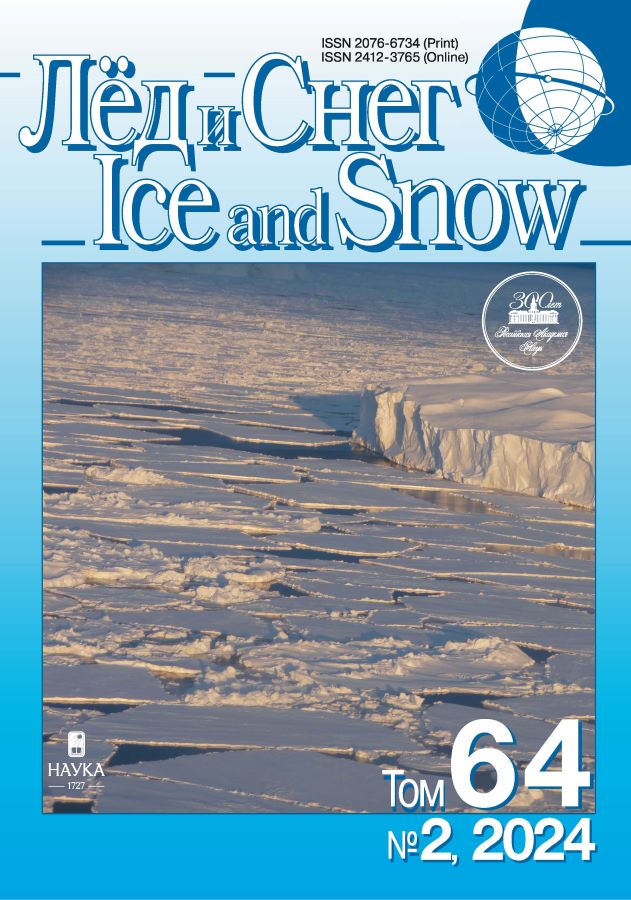Mechanism of ion migration from the substrate material into snow cover at the end of the cold period
- Authors: Fedoseeva V.I.1,2
-
Affiliations:
- M.K. Ammosov North-Eastern Federal University
- P.I. Melnikov Permafrost Institute of Siberian Branch of the RAS
- Issue: Vol 64, No 2 (2024)
- Pages: 231-237
- Section: Snow cover and avalanches
- URL: https://journals.eco-vector.com/2076-6734/article/view/659275
- DOI: https://doi.org/10.31857/S2076673424020062
- ID: 659275
Cite item
Abstract
Earlier, it was established that maximum mineralization of the contact layer of snow occurs in spring at the interface with substrates (soil or ice). This study analyzes the temperature and moisture conditions during this period at the interface of the contact layer of snow with substrates by examining frozen sand blocks saturated with a solution containing complex gold ions, or blocks filled with polystyrene containing ions of molybdenum, copper, etc. It is assumed that the migration of ions from the underlying substrate into the contact layer of snow cover in spring occurs along quasi-liquid films on the surface of snow crystals, the thickness of which exceeds the equilibrium one. Migration becomes noticeable when the temperature at the snow–substrate contact reaches −13 °С and above. The appearance of quasi-liquid films on the surface of snow particles under variable temperature and moisture conditions is possible due to the condensation of water vapor, which during the day, with general heating of the system, can enter the contact layer of snow both from above and below. With an increase in snow density in the spring, the mineralization of the near-contact layer of snow cover increases. At the same time, linear relationships were revealed between the content of substrate components migrating into the near-contact layer of snow and the gradient of water vapor density in it. The reliability of the approximation of these dependencies for the gold thiosulfate complex is 0.98; for copper ions – 0.52; for hydrogen ions – 0.88; for sodium ions – 0.69, for chloride anions – 0.89. The results of the study substantiate the increased efficiency of geochemical prospecting for mineral deposits using snow cover in the spring.
Full Text
About the authors
V. I. Fedoseeva
M.K. Ammosov North-Eastern Federal University; P.I. Melnikov Permafrost Institute of Siberian Branch of the RAS
Author for correspondence.
Email: vifgoreva@gmail.com
Russian Federation, Yakutsk; Yakutsk
References
- Battan L. J. Chelovek budet izmenjat’ prirodu. Man will change the weather. Leningrad: Hydrometeoizdat, 1965: 112 p. [In Russian].
- Vasilenko V. M., Nazarov I. M., Fridman Sh. D. Monitoring zagrjazneniya snezhnogo pokrova. Snow cover pollution monitoring. Leningrad: Hydrometeoizdat, 1985: 192 p. [In Russian].
- Golubev V. N., Frolov D. M. Water vapor flows across snow-air and snow-soil interfaces. Kriosfera Zemli. Cryosphere of the Earth. 2015, 19 (1): 20–25.
- Isakova O. P., Tarasevich Ju. Yu., Juzjuk Ju. I. Obrabotka I vizualizatsiya dannyh fizicheskih eksperimentov s pomoshch’u paketa Oridin. Processing and visualization of data from physical experiments using the Origin software package. Moscow: Book house “LIBROCOM”, 2009: 136 p. [In Russian].
- Lebedenko Ju. P. Cryogenic migration of ions and bound moisture in ice-saturated dispersed rocks. Inzhenernaja Geologija. Engineering geology. 1989, 4: 21–30. [In Russian].
- Lukashev V. K., Nikitina R. A., Vasilieva L. I., Leskovets G. V. Use of snow in geochemical prospecting. Doklady Belarusskoji Academii nauk. Reports of the Belarusian Academy of Science. 1987, 31 (4): 161–176. [In Russian].
- Makarov V. N. Geokhimicheskije polja v kriolitozone. Geochemical fields in permafrost. Yakutsk: IMZ SO RAN, 1998: 116 p. [In Russian].
- Makarov V. N., Fedoseeva V. I., Fedoseev N. F. Geokhimija snezhnogo pokrova Jakutii. Geochemistry of the snow cover of Yakutia. Yakutsk: IMZ SB USSR AN, 1990: 148 p. [In Russian].
- Meteorologicheskiji ezhemesjachnik. Chast’ 2. Meteorological monthly. Part 2. Issue 24. № 1–4. Yakutsk, 1987: 73 p. [In Russian].
- Pavlov A. V. Teplophizika landshaftov. Thermophysics of landscapes. Novosibirsk: Nauka, 1979: 285 p. [In Russian].
- Spravochniki ТehTab.ru Retrieved from: http://tehtab.ru/Guide/GuidePhysics/Humidity/SaturatedOverIce/ (Last access: 18 September 2023). [In Russian].
- Fedoseeva V. I. Phiziko-khimicheskije zakonomernosti migratsii khimicheskikh elementov v mjorzlykh gruntakh I snege. Physico-chemical regularities of chemical element migration in frozen soils and snow. Yakutsk: IMZ SB RAN, 2003: 138 p. [In Russian].
- Fedoseeva V. I. Cyclic migration of chemical elements at the soil-snow interface. Materialy Gljatsiologicheskikh Issledovaniji. Data of Glaciological Studies. 2002, 92: 192–194.
Supplementary files















